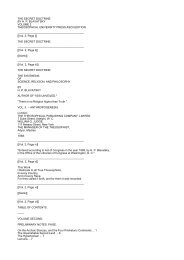Create successful ePaper yourself
Turn your PDF publications into a flip-book with our unique Google optimized e-Paper software.
The Principal Geographical And Mythological Places In The <strong>Book</strong> Of The <strong>Dead</strong>.<br />
<strong>the</strong> word is "it never sprouteth."<br />
An-tes(?) (see within, p. 323), an unknown locality where a light tower (?), was adored.<br />
Apu, <strong>the</strong> Panopolis <strong>of</strong> <strong>the</strong> Greeks ({Greek Panw^n po'lis}, Strabo, XVII., i., 41), <strong>the</strong> metropolis <strong>of</strong> <strong>the</strong><br />
ninth nome <strong>of</strong> Upper Egypt, and <strong>the</strong> seat <strong>of</strong> <strong>the</strong> worship <strong>of</strong> <strong>the</strong> god ###, whose name is variously read<br />
Amsu, Khem, and Min. In ancient days it was famous as <strong>the</strong> centre for stone cutting and linen weaving,<br />
and <strong>the</strong> latter industry still survives among <strong>the</strong> modern Coptic population, who, following <strong>the</strong>ir ancestors,<br />
call <strong>the</strong>ir city ###, which <strong>the</strong> Arabs have rendered by Akhmîm.<br />
Aqert, a common name for <strong>the</strong> abode <strong>of</strong> <strong>the</strong> dead.<br />
Bast, more fully Pa-Bast or Per-Bast, <strong>the</strong> Bubastis <strong>of</strong> <strong>the</strong> Greek writers (Herodotus, II., 59, 137, 156,<br />
166; Strabo, XVII., 1, 27), <strong>the</strong> metropolis <strong>of</strong> <strong>the</strong> eighteenth nome <strong>of</strong> Lower Egypt, and <strong>the</strong> seat <strong>of</strong> <strong>the</strong><br />
worship <strong>of</strong> Bast, a goddess who was identified with <strong>the</strong> soul <strong>of</strong> Isis, ba en Auset. The city is mentioned in<br />
<strong>the</strong> Bible under <strong>the</strong> form ### (Ezekiel xxx., 17), Pi-beseth,<br />
[1. See Amélineau, op. cit., p. 287.]<br />
{p. cxxxv}<br />
which <strong>the</strong> Copts have preserved in <strong>the</strong>ir name for <strong>the</strong> city, ###; <strong>the</strong> Arabs call <strong>the</strong> place Tell Basta.<br />
Het-benbent, <strong>the</strong> name given to many sun-shrines in Egypt, and also to one <strong>of</strong> <strong>the</strong> places in <strong>the</strong> o<strong>the</strong>r<br />
world where <strong>the</strong> deceased dwelt.<br />
Het-Ptah-ka, <strong>the</strong> sacred name <strong>of</strong> <strong>the</strong> city <strong>of</strong> Memphis, <strong>the</strong> metropolis <strong>of</strong> <strong>the</strong> first nome <strong>of</strong> Lower Egypt;<br />
it means <strong>the</strong> "House <strong>of</strong> <strong>the</strong> ka <strong>of</strong> Ptah," and was probably in use in <strong>the</strong> period <strong>of</strong> <strong>the</strong> Ist dynasty. O<strong>the</strong>r<br />
names for Memphis were Aneb-het'et, "<strong>the</strong> city <strong>of</strong> <strong>the</strong> white wall", Men-nefer and Kha-nefert.<br />
Kem-ur a name given to <strong>the</strong> district <strong>of</strong> <strong>the</strong> fourth and fifth nomes <strong>of</strong> Upper Egypt.<br />
Khemennu, i.e., <strong>the</strong> city <strong>of</strong> <strong>the</strong> eight great cosmic gods, <strong>the</strong> Hermopolis <strong>of</strong> <strong>the</strong> Greek writers ({Greek<br />
E?'rmopolitikh` fulakh`}, Strabo, XVII., I, 41), and <strong>the</strong> metropolis <strong>of</strong> <strong>the</strong> fifteenth nome <strong>of</strong> Upper Egypt.<br />
The old Egyptian name for <strong>the</strong> city is preserved in its Coptic and Arabic names, ### and Eshmûnên.<br />
Kher-aba, a very ancient city which was situated on <strong>the</strong> right bank <strong>of</strong> <strong>the</strong> Nile, a little to <strong>the</strong> south <strong>of</strong><br />
Annu, near <strong>the</strong> site <strong>of</strong> which <strong>the</strong> "Babylon <strong>of</strong> Egypt"[1] (<strong>the</strong> {Greek Babulw'n, frou'rion e?rumno'n} <strong>of</strong><br />
Strabo, XVII., I, 30), was built.<br />
Manu is <strong>the</strong> name given to <strong>the</strong> region where <strong>the</strong> sun sets, which was believed to be exactly opposite to<br />
<strong>the</strong> district <strong>of</strong> Bekha, where he rose in <strong>the</strong> east; Manu is a synonym <strong>of</strong> west, just as Bekha is a synonym<br />
<strong>of</strong> east.[2]<br />
Nekhen, <strong>the</strong> name <strong>of</strong> <strong>the</strong> shrine <strong>of</strong> <strong>the</strong> goddess Nekhebet, which is supposed to have been near to<br />
Nekheb, <strong>the</strong> capital <strong>of</strong> <strong>the</strong> third nome <strong>of</strong> Upper Egypt and <strong>the</strong> Eileithyiapolis <strong>of</strong> <strong>the</strong> Greeks.<br />
Neter-khertet, a common name for <strong>the</strong> abode <strong>of</strong> <strong>the</strong> dead; it means <strong>the</strong> "divine subterranean place."<br />
[1. See Amélineau, op. cit., p. 75.<br />
2 See Brugsch, Diet. Géog., pp. 199, 260; Maspero, Études de Mythologie, t. i., p. 332; and Aeg. Zeitschrift, 1864, pp.<br />
http://www.sacred-texts.com/egy/ebod/ebod10.htm (2 <strong>of</strong> 4) [8/10/2001 11:24:04 AM]

















